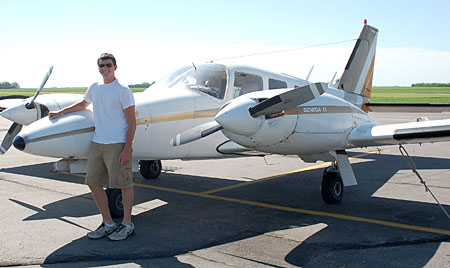Kenmare ND - Features
Real People. Real Jobs. Real Adventures.
Thanks for reading some of the latest features about area people and events.
To view every page and read every word of The Kenmare News each week,
subscribe to our ONLINE EDITION!
Two "Kenmare boys" spend their summer flying into storms
When the thunder starts rumbling before a summer storm in Ward County, most folks head indoors and shut the windows to wait out the weather. Contrary to common sense, Chad Gravesen and Derek Peterson make a dash for their airplane.
7/21/10 (Wed)
When the thunder starts rumbling before a summer storm in
Contrary to common sense, Chad Gravesen and Derek Peterson make a dash for their airplane.
More specifically, for the twin engine Piper Seneca tied down at the
The NDCMP accepted only nine interns for the 2010. “A lot of the time, they don’t even have any
“We had to take two semesters of weather modification and an advanced weather modification class,” added
Derek laughed as he talked about how often he is asked about flying into thunderstorms. “It’s good flying experience,” he said, “flying around weather like that. It’s a flying experience you’d never get anywhere else.”
“It’s a good way to build hours and flight time for my future career,” said
Those family members include his father, a former NDCMP pilot himself flying now for Delta Airlines, and his cousin Kelly Gravesen, who also flies for Delta. Immediately after finishing high school,
The NDCMP continues through the end of August, but
Derek Peterson
Derek, the son of Curtis and Susie Peterson, didn’t come from a flying family like
Grandfather and grandson would spend hours together poring over a collection of books about airplanes that Eldon kept in his living room. “He worked on planes in
He paused and grinned. “But what really got me hooked was watching Brekhuses spray,” he said, referring to Great Plains Aero operated by Palmer and Karen Brekhus and their son Julius Brekhus.
Derek started flying during his first year at Williston State College, taking private lessons at age 18 in a single engine Piper Warrior and earning his license by age 19. He completed his general courses at Williston, then transferred to UND starting his sophomore year.
He admitted that working as a spray pilot interested him following graduation, given his own interest in farming. “The airlines aren’t really hiring right now, because of the economy,” he said, adding he would prefer to work as a corporate or charter pilot anyway because of the scheduling and the time away from home.
Then he smiled again. “And I’m working on getting my own plane,” he said.
Seeking the
perfect updraft
Even as they talk about their futures as pilots,
“It’s one of the easiest jobs I’ve had,” Derek added. “Sometimes we fly all night and sleep all day. On the morning of July 3rd, I was out from midnight until eight in the morning.”
Actually, the intern pilots assist NDCMP pilot Greg Shepherd in Kenmare with maintenance on the plane and keeping the chemicals stocked and mixed for flights. “We pay attention to the radar and the weather,” Derek said, “and we get daily briefings at noon.”
“There are two radar [centers] in
If thunderstorms appear imminent for the day, the pilots preflight the plane and prepare the chemicals. Then they wait at the airport for further instructions.
“We’re looking for a big, puffy cloud,” said Derek, describing the ideal cloud tops as looking like cauliflower. “We want those crisp clouds with height and a smooth dark face on the bottom.”
The pilots watch for a shelf cloud under the thunderstorm. Using their gauges for engine pressure and vertical speed, they locate areas of updraft and relay the information to the
“We tell them what we’re seeing and feeling for the updraft,”
The plane releases silver iodide from two wing-tip generators “We can see flames when we’re flying at night as the silver iodide is released,”
“It’s critical that we release chemical at the right time in the right place,” added Derek. “Clouds don’t last very long. And it’s actually quite a smooth flight. On top of the storm would be more turbulent.”
The silver iodide acts as a substitute for ice crystals in the storm cloud, and allows super-cooled liquid water in the cloud to freeze. According to the ND ARB, seeding effects can be seen any time from almost immediately to within 30 minutes, depending on conditions and the seeding method.
The desired result is increased precipitation production of the cloud. “If you turn around and look [after seeding], you can see the clouds kind of dissipating,” said Derek, “but it’s hard to see any results at night.”
If hail is forming in the cloud, the goal of seeding is to suppress its development. “We can’t deny it’s going to start hailing,” Derek explained. “We try to make it hail smaller so it melts before it hits the ground. So it may come down the size of peas or marbles, instead of something bigger.”
If the goal is rain enhancement, seeding leads to quicker rain production, which may or may not fall exactly where farmers want the moisture. “We just make it rain sooner,” Derek said. “We can only work with the clouds and what the clouds give us.”
Storms mean
more flying time
The 2010 season started with fairly active weather. By the beginning of July,
Although most of the flights are routine and the pilots follow strict safety procedures, he recalled a few particular moments. “We’ve had one lightning strike this year,” he said, “and for our storm on the night of July 1st, we had three planes up. We could see it from a ways away, and we were looking for lightning so we would know where the thunderstorm was at and know where to avoid.”
He and Shepherd couldn’t actually find anywhere suitable to seed in that storm. “We had to land, then the storm blew up and moved out of our district,” he said.
Storms on the night of June 24th, which produced hail, rain, strong winds and tornadoes, proved to be exciting. “We were up for three and a half hours,”
Derek described one uncomfortable night of flying. “We were high in the clouds, looking for the thunderstorm, and we were bouncing around really well,” he said. “The lightning was like strobe lights and we could see ice building up on the wings. We were up for about an hour and both of us were getting queasy.”
He and the pilot finally decided to land in order to clear the ice. “Then, we returned to the storm and dropped about 60 flares into it,” he said.
Both Derek and
NDCMP active
in six counties
The NDCMP operates in two districts in the state, including District 1 in Slope and Bowman counties and District II in Ward, Mountrail, Williams and McKenzie counties. Counties pay about two-thirds of the expenses for the project, with cost-share funds provided by the State for the balance. Cost of the 2010 NDCMP was expected to be 12.5 cents per acre.
From time to time, results of seeding are documented and studied to evaluate the effectiveness of the program. Hail data collected during the 1970s from the North Dakota Pilot Project showed less hail on seed days than on no-seed days, and lower crop-hail insured losses on seed days than on no-seed days. In fact, a 1997 study of crop-hail insurance data estimated a 45 percent reduction of crop-hail damage in the seeded counties.
Analysis of rainfall data recorded during the 1970s suggested an increase of approximately one inch of precipitation during the growing season, an increase of 5 to 10 percent over the average.
In terms of economic benefits, a 2009 study by
For
“The best part is getting to fly a twin engine and help out the local area,” added Derek, “but then I get blamed for making it hail!”



